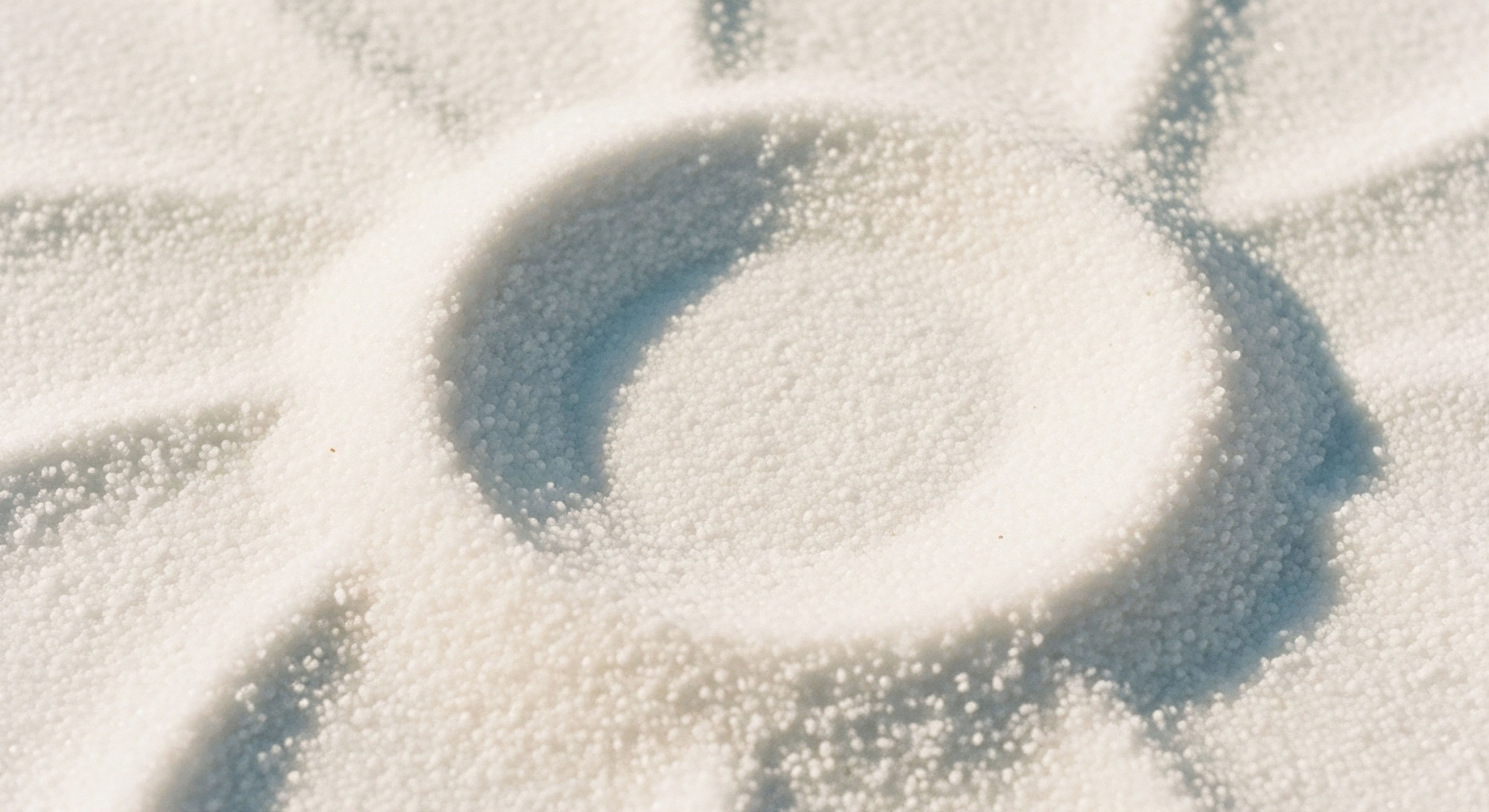

Fundamentals
You have likely noticed a change in the mirror. It may be a subtle shift in the texture of your skin, or perhaps a fine line that has deepened near your eyes or mouth. This observation is a tangible connection to a profound biological conversation happening within your body.
The appearance of these lines is a direct message from your endocrine system, the intricate network of glands that produces and manages your body’s hormonal messengers. Understanding this conversation is the first step toward addressing these changes from their core, moving beyond surface-level treatments to support the very foundation of your skin’s vitality.
Your skin possesses a remarkable architecture, a living matrix responsible for its firmness, resilience, and hydration. The primary structural protein in this matrix is collagen, a fibrous substance that provides the skin with its strength and scaffolding. Think of it as the frame of a building, giving everything its shape and durability.
Interwoven with collagen is elastin, another protein that, as its name suggests, provides elasticity. Elastin allows your skin to stretch and return to its original shape. The entire matrix is bathed in a substance rich in hyaluronic acid, a molecule that can hold many times its weight in water, ensuring the skin remains hydrated, plump, and supple. The health and abundance of these components are directly orchestrated by hormonal signals.
The visible signs of skin aging are external reflections of internal hormonal shifts that alter the skin’s foundational structure.
Hormones function as the body’s internal communication service, sending precise instructions to cells throughout every system, including the skin. For the purposes of skin health and the appearance of fine lines, three communicators are of primary importance ∞ estrogen, testosterone, and growth hormone. Each carries a specific set of instructions for the cells within the dermal layers.

The Role of Estrogen in Skin Architecture
Estrogen, particularly estradiol, is a powerful signaling molecule for maintaining youthful skin in women. It directly communicates with skin cells called fibroblasts, instructing them to produce both collagen and elastin. High levels of estrogen correspond to thicker, more hydrated skin with a robust collagen framework.
This hormone also stimulates the production of hyaluronic acid, which is fundamental for maintaining the skin’s moisture content and volume. During the perimenopausal and menopausal transitions, the decline in estrogen production sends a different set of signals. Fibroblasts receive fewer instructions to build, leading to a quantifiable reduction in collagen synthesis.
Studies have shown that in the years following menopause, skin can lose a significant percentage of its collagen annually, resulting in thinner, drier skin that is more prone to the formation of wrinkles.

Testosterone and Its Influence on Dermal Integrity
In both men and women, testosterone contributes to skin health, although its mechanisms differ slightly from estrogen. For men, testosterone is a primary driver of skin thickness. It supports robust collagen production, which is one reason men’s skin often appears thicker and ages at a different rate than women’s skin.
This hormone also influences the sebaceous glands, promoting the production of sebum, the skin’s natural oil. Sebum provides a protective lipid layer that helps lock in moisture. As men experience age-related androgen decline, or andropause, the reduction in testosterone signaling contributes to a decrease in both collagen density and sebum production.
The skin may become drier and lose some of its structural firmness, making fine lines and wrinkles more apparent. In women, a balanced level of testosterone also supports skin integrity and libido, and its decline can contribute to changes in skin texture.

Growth Hormone the Master Repair Signal
Human Growth Hormone (HGH) is a foundational hormone for cellular growth, reproduction, and regeneration throughout the body. Its effect on the skin is profound. HGH, and the peptides that stimulate its release, signal the body to repair and rebuild tissues, including the dermal matrix.
It promotes the proliferation of fibroblasts and keratinocytes, the cells that make up the skin’s structure. By supporting the synthesis of new collagen and other matrix proteins, growth hormone helps maintain skin thickness, firmness, and smooth texture.
The natural decline of HGH production that begins in early adulthood and accelerates with age is a key factor in the overall aging process, including the visible signs on the skin. A reduction in these vital repair signals means that the daily damage incurred from environmental exposures is repaired less efficiently, leading to a gradual degradation of the skin’s quality.


Intermediate
Understanding that hormonal decline is a root cause of skin aging opens a new perspective on intervention. Hormonal optimization protocols are designed to re-establish the biochemical signals that support the skin’s structural matrix. This approach involves a precise recalibration of the body’s endocrine system, using bioidentical hormones and targeted peptides to replenish the messengers that instruct skin cells to maintain their youthful function.
The goal is to work with the body’s own communication pathways to restore the integrity of the skin from within.

How Do Clinicians Tailor Protocols for Individual Needs?
Effective hormonal therapy is a highly personalized science. It begins with comprehensive laboratory testing to establish a baseline of an individual’s unique endocrine profile. This includes measuring levels of key hormones like estradiol, progesterone, total and free testosterone, and markers that indicate growth hormone levels, such as IGF-1.
Based on this data, alongside a thorough evaluation of symptoms and personal health history, a clinician can design a protocol that addresses specific deficiencies and restores hormonal balance. This is a dynamic process, requiring ongoing monitoring and adjustments to ensure the protocol remains optimized for the individual’s needs and goals.

Female Hormonal Recalibration Protocols
For women experiencing perimenopause or post-menopause, the primary goal is often to replenish declining estrogen levels. This is typically achieved using bioidentical estradiol, which is molecularly identical to the hormone produced by the body. Progesterone is also a critical component of female protocols, particularly for women with an intact uterus, as it provides endometrial protection. These hormones can be administered through various methods, each with its own set of characteristics.
| Delivery Method | Description | Considerations |
|---|---|---|
| Oral Tablets | Estradiol and progesterone are taken in pill form. The hormones are processed through the liver before entering systemic circulation. | This method is convenient but involves a “first-pass” metabolism in the liver, which can affect clotting factors and may not be suitable for everyone. |
| Transdermal Patches | A patch applied to the skin releases a steady dose of hormones directly into the bloodstream over several days. | This avoids the first-pass liver metabolism and provides consistent hormone levels, which can be beneficial for symptom control. |
| Topical Gels/Creams | Hormones are applied to the skin daily. This method also bypasses the liver. | Offers daily dosing flexibility. Proper application site and absorption are important for efficacy. Topical estrogen can have direct benefits on the skin where it is applied. |
| Subcutaneous Injections | Testosterone Cypionate, often in low doses (e.g. 10-20 units weekly), can be administered via a small subcutaneous injection to support energy, libido, and skin quality. | Provides direct and reliable absorption. This is a common protocol for adding the benefits of testosterone to a woman’s regimen. |
In addition to estrogen and progesterone, many women benefit from the inclusion of low-dose testosterone. Testosterone in women is vital for muscle tone, energy, cognitive function, and libido. It also contributes directly to the skin’s collagen framework, and its restoration can significantly enhance the skin-rejuvenating effects of a protocol.

Male Hormonal Optimization Protocols
For men with symptoms of andropause and confirmed low testosterone levels, Testosterone Replacement Therapy (TRT) is the standard of care. The objective is to restore testosterone to an optimal physiological range, thereby alleviating symptoms and supporting overall health, including skin integrity. A comprehensive male protocol is often multifaceted.
- Testosterone Cypionate This is a common form of bioidentical testosterone administered via weekly intramuscular injections. This method ensures a stable and predictable level of testosterone in the body, supporting consistent benefits for muscle mass, energy, and skin health.
- Gonadorelin This peptide is included to maintain the function of the Hypothalamic-Pituitary-Gonadal (HPG) axis. It mimics the body’s own Gonadotropin-Releasing Hormone (GnRH), signaling the testes to continue their own production of testosterone and maintaining fertility.
- Anastrozole Testosterone can be converted into estrogen in the male body by an enzyme called aromatase. Anastrozole is an aromatase inhibitor used in small doses to manage estrogen levels and prevent potential side effects like water retention.
A well-designed hormonal protocol is a symphony of synergistic agents, each playing a specific role in restoring the body’s natural endocrine harmony.

The Role of Growth Hormone Peptides
Growth Hormone Peptide Therapy is a sophisticated approach that complements hormonal replacement. Instead of administering synthetic HGH directly, this therapy uses specific peptides that stimulate the pituitary gland to produce and release its own growth hormone. This is considered a more biomimetic approach, as it works within the body’s natural feedback loops. Peptides like Sermorelin, Ipamorelin, and CJC-1295 are frequently used.
These peptides bind to receptors in the pituitary gland, triggering the natural pulse of HGH release that is characteristic of youth. The resulting increase in circulating HGH and its downstream mediator, IGF-1, enhances cellular repair processes throughout the body. For the skin, this translates to increased collagen and elastin synthesis, improved skin thickness, and a more rapid regeneration of skin cells, which contributes to a reduction in the appearance of fine lines and a healthier, more resilient skin texture.


Academic
A granular examination of how hormonal optimization impacts skin aesthetics requires a journey into the cellular and molecular biology of the dermis. The visible reduction in fine lines is the macroscopic outcome of a complex series of microscopic events initiated by the binding of a hormone to its specific receptor.
The interaction between estradiol and its receptors in dermal fibroblasts provides a compelling model for understanding this process. This is a story of gene transcription, protein synthesis, and enzymatic regulation, all orchestrated by the precise language of endocrine signaling.

What Are the Molecular Mechanisms of Hormonal Skin Aging?
The primary effectors of estrogen’s action in the skin are two nuclear hormone receptors ∞ Estrogen Receptor Alpha (ERα) and Estrogen Receptor Beta (ERβ). Both are present in key skin cells, including keratinocytes, fibroblasts, and melanocytes, with ERβ being the predominant form in fibroblasts.
When an estrogen molecule, such as 17β-estradiol from a therapeutic protocol, enters a fibroblast, it binds to these receptors in the cytoplasm. This binding event causes a conformational change in the receptor, activating it and causing it to translocate into the cell nucleus.
Once inside the nucleus, the activated estrogen-receptor complex functions as a transcription factor. It binds to specific DNA sequences known as Estrogen Response Elements (EREs) located in the promoter regions of target genes. This binding initiates the transcription of these genes into messenger RNA (mRNA), which is then translated into proteins by the cell’s ribosomal machinery. This entire process is the central mechanism by which estrogen directly upregulates the production of the skin’s structural components.
Hormone replacement therapy effectively reactivates dormant genetic blueprints for collagen and elastin production within the skin’s own cells.

Upregulation of Structural Protein Synthesis
The most significant target genes for skin health are those that code for collagen and elastin. Specifically, estrogen receptor activation has been shown to increase the transcription of the COL1A1, COL1A2, and COL3A1 genes, which are responsible for producing Type I and Type III procollagen molecules, respectively.
These are the two most abundant types of collagen in the skin. After being synthesized, these procollagen molecules are secreted from the fibroblast into the extracellular matrix, where they are cleaved by enzymes to form tropocollagen. These tropocollagen units then self-assemble into strong collagen fibrils, reinforcing the skin’s dermal scaffold.
A similar transcriptional activation occurs for the gene that produces tropoelastin, the precursor to elastin fibers. This dual action rebuilds both the strength and the flexibility of the dermis at a molecular level.
| Target Gene/Protein | Function | Effect of Estrogen Signaling |
|---|---|---|
| COL1A1, COL3A1 | Code for Type I and Type III procollagen, the primary structural proteins of the dermis. | Increased transcription, leading to greater synthesis of new collagen fibrils and a denser dermal matrix. |
| ELN (Elastin) | Codes for tropoelastin, the precursor to elastin fibers which provide skin its elasticity. | Upregulation of synthesis, improving the skin’s ability to recoil and reducing laxity. |
| HAS (Hyaluronan Synthase) | Enzymes that synthesize hyaluronic acid, a key glycosaminoglycan for hydration. | Stimulation of activity, leading to increased water retention, dermal volume, and turgor. |
| MMPs (Matrix Metalloproteinases) | A family of enzymes (e.g. collagenase, elastase) that degrade extracellular matrix proteins. | Downregulation of expression and activity, preserving existing collagen and elastin from breakdown. |

Systemic Interplay and the HPG Axis
This cellular activity does not occur in isolation. It is the end point of a systemic cascade governed by the Hypothalamic-Pituitary-Gonadal (HPG) axis. In a premenopausal woman, the hypothalamus releases GnRH, which stimulates the pituitary to release Luteinizing Hormone (LH) and Follicle-Stimulating Hormone (FSH).
These hormones signal the ovaries to produce estrogen. In menopause, this signaling breaks down. A properly dosed HRT protocol effectively bypasses the dysfunctional parts of this axis, delivering the final chemical message (estradiol) directly to the target tissues, like the skin.
Similarly, TRT in men and peptide therapies that act on the pituitary are interventions designed to restore function at specific points along these complex neuro-endocrine feedback loops. The result is a coordinated, systemic restoration of anabolic and regenerative signaling that manifests as improved physiological function and a visible enhancement in skin quality.

Do Genetic Factors Influence Hormonal Effects on Skin?
The response of an individual’s skin to hormonal optimization is also modulated by genetic factors. Polymorphisms, or variations, in the genes that code for estrogen receptors (ESR1 and ESR2) can affect the binding affinity and transcriptional efficiency of the receptors.
This means that two individuals on the exact same protocol may experience different degrees of collagen synthesis in response to the therapy. Furthermore, genetic predispositions in collagen metabolism and the activity of MMP enzymes can influence the net balance between protein synthesis and degradation. This highlights the deep individuality of the aging process and reinforces the necessity of a personalized clinical approach that considers not just hormone levels, but the patient’s entire biological context.

References
- Lephart, Edwin D. and Frederick Naftolin. “Updated Perspectives on the Role of Estrogens in Skin Aging.” Clinical, Cosmetic and Investigational Dermatology, vol. 14, 2021, pp. 183-94.
- Thornton, M. J. “Estrogens and aging skin.” Dermato-endocrinology, vol. 5, no. 2, 2013, pp. 264-70.
- Stevenson, S. and J. Thornton. “Effect of estrogens on skin aging and the potential role of SERMs.” Clinical Interventions in Aging, vol. 2, no. 3, 2007, pp. 283-97.
- Watanabe, M. et al. “Modulating testosterone pathway ∞ a new strategy to tackle male skin aging?” Clinical, Cosmetic and Investigational Dermatology, vol. 11, 2018, pp. 337-42.
- Son, E. D. et al. “Topical application of 17beta-estradiol increases extracellular matrix protein synthesis by stimulating TGF-beta signaling in aged human skin in vivo.” The Journal of Investigative Dermatology, vol. 124, no. 6, 2005, pp. 1149-61.
- Brincat, M. P. et al. “A study of the decrease in skin collagen content, skin thickness, and bone mass in the postmenopausal woman.” Obstetrics and Gynecology, vol. 70, no. 6, 1987, pp. 840-45.
- “Growth Hormone Peptides (GhRP) ∞ A Proven Anti-Aging Solution Gaining Popularity.” Performance Rejuvenation Center, 2023.
- “Sermorelin Peptide Therapy in Oklahoma ∞ The Secret to Youthful Skin.” NP2GO, 2023.

Reflection
The information presented here provides a map of the biological pathways that connect your internal hormonal state to the reflection you see in the mirror. It details the specific messengers and the cellular conversations that construct, maintain, and repair your skin.
This knowledge is a powerful tool, shifting the perspective from one of passive aging to one of proactive, informed self-stewardship. The lines on your skin are not an endpoint; they are a data point. They signal a change in your body’s internal environment.
The next step in this personal health investigation involves translating this foundational knowledge into a personalized strategy. This journey is best undertaken with a qualified clinical guide who can help you interpret your own unique biological signals and co-create a protocol that aligns with your specific physiology and life goals. Your body is constantly communicating its needs. The opportunity now is to listen and respond with precision and intention.



